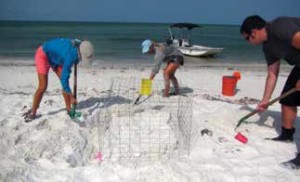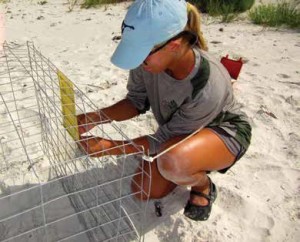Protecting Sea Turtles One Nest at a Time
by Brigid O’Malley
By 8 a.m., they’re ready to start their adventure.
Sarah Norris and Anna Windle, interns assigned to keep a protective eye on the sea turtles and their nests this summer on Cape Romano in Rookery Bay National Estuarine Research Reserve, check the weather radar on their phones. As the clouds move away, they pack up to go out on the water for their tour of the beaches. Wire cages, shovels, GPS, a camera and some rain gear are brought aboard their vessel.
“It looks like it’s getting better,’’ says Norris, a 2013 graduate of Florida Gulf Coast University, as they wait to start their morning trip on the Tursiops. Their goal: Search the beaches for any signs, no matter how slim, of turtle nests.
Windle, who attends Washington College in Maryland, and Norris both came to Rookery Bay Reserve in Naples specifically to monitor sea turtle nesting activity.
Rookery Bay offers one of the few sea turtle intern programs in the region.
The allure of these crab and snail eating turtles that weigh in at up to 400 pounds and nest on our shores?
“They’re just awesome,’’ Norris said. “They’ve been around for so long. What makes them the most interesting is that they come back over and over to the same beaches to make their nests.”
This nesting season has been a busy one, with nearly half of the turtle nests in Collier County on beaches protected within reserve boundaries. According to Collier County environmental specialists, 154 nests have been reported so far, compared to 103 at the same time last year. Rookery Bay Reserve encompasses beaches on Keewaydin Island, Kice Island, Cape Romano and the Ten Thousand Islands. County-wide, nests are up from 236 at this time last year to 413 so far this year, with many partners assisting in their protection.

SEA TURTLE INTERNS AND VOLUNTEERS PLACE WIRE CAGES OVER EACH NEST ON CAPE ROMANO TO PROTECT THE EGGS FROM PREDATORS, SUCH AS RACCOONS.
“It takes a collective effort to monitor and protect all of these nests,” said Jill Schmid, one of the biologists responsible for managing Rookery Bay Reserve’s turtle monitoring program. “So far the nesting season has been sensational,” she added. But having a lot of nests is only half of the story.
Rookery Bay’s interns are two of the turtle gumshoes tracking down clues – and info on sea turtles and their nests.
Five days per week, the two interns leave the dock at Goodland and head into reserve waters. Once they reach the beaches, the two are eyeing the shores for evidence of turtle nesting sites. False crawls are common. That means the tracks show the sea turtle came ashore, but something sent it back into the water, maybe to return later on, or to come back to a different spot.
“They could hit a stump and get scared. Or they just didn’t like the sand or they’re hitting vegetation,’’ said Windle. She said looking for that telltale fluffy sand where the turtle uses her back fins to kick the sand is usually a good sign.
The monitoring team will carefully probe into the sand around the possible nest to verify there are eggs below, and then use their hand to find the egg chamber.
“It’s an awesome feeling when you determine it’s a nest,’’ Windle said.
Norris said sometimes they feel they might be on the trail of a nest, but do not find the chamber.
“You have to make sure it’s not a ghost crab tunnel,’’ she said. Windle admits that she’s run into them, but Norris, the more experience turtle researcher, assures her everyone does. On a recent trip, they found six false crawls and one nest.
“You’re kind of investigating what did she do, where did she go, what path did she take,’’ Windle said.
The interns are out on Saturdays and when they reach more populated areas, they sometimes get questions about what they’re
doing as they walk the beaches. Others look at them and say, “Oh, turtles, right.”
Once the nest is located they place a wire cage over the nest so that predators can’t get into the nest. Then they’ll get all the specifics on location and log it in.
The big news will be when the hatching starts. Norris has seen that. For Windle, it’ll be a first.
The hatchlings will make their way out of the sand at night or early in the morning in the cooler weather, Norris explains. More
than 100 may come from a single nest.
“A couple might get a head start and then they just start bubbling out,’’ she said. “They just know what to do.”
Norris said looking for depressions or little tracks is the way to find out if the turtles made it out. About three days later, they’ll dig up the nest for evaluation. They will often find some live turtles that need a little help, some who are partly out of their shell and some that are dead.
“It’s pretty rewarding,’’ she said. “Especially after being out there for two or three months, doing all of the work of protecting the nest.’’
So those long mornings, rainy afternoons out on the boat, navigating to the different beaches where they walk and then dig and
cage the nests, it’s all worth it. “Definitely,’’ Windle said.
The Rookery Bay Reserve waters so far have given the two an up-close look at Southwest Florida marine inhabitants, from a 6-foot nurse shark, to dolphins, manatees and sea turtles coming to the surface.
The two agree that sea turtles are their future. Norris aims to complete her Master’s degree at FGCU with a project on sea turtles and Cape Romano and Keewaydin Island, while Windle’s hoping to work with marine life after she graduates.
“Sea turtles, definitely,’’ Windle said.
Volunteers welcome. Learn more about Rookery Bay Reserve’s sea turtle program at www.rookerybay.org.



Leave a Reply
Want to join the discussion?Feel free to contribute!